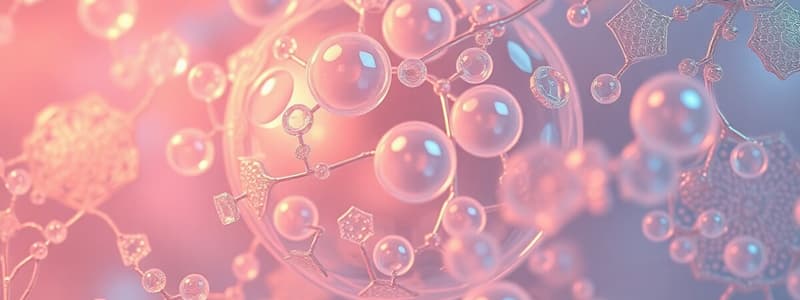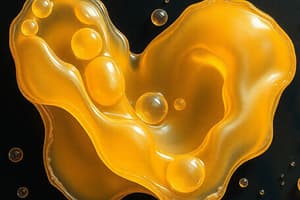Podcast
Questions and Answers
Which method is used to further purify the copolymer hydrogels after centrifugation?
Which method is used to further purify the copolymer hydrogels after centrifugation?
- Chemical treatment with solvents
- Dialysis through a filter (correct)
- Filtration through a fine mesh
- Freeze-drying under vacuum
What was the temperature maintained during the dialysis process for the hydrogels?
What was the temperature maintained during the dialysis process for the hydrogels?
- 40 ◦C
- 15 ◦C
- 25 ◦C (correct)
- 30 ◦C
What happens to the phases of the polymerization reaction if the time exceeds 180 minutes?
What happens to the phases of the polymerization reaction if the time exceeds 180 minutes?
- The phases start to separate (correct)
- The polymerization stops completely
- The reaction becomes faster
- The reaction stabilizes
Which technique was NOT mentioned as a characterization method for the synthesized hydrogels?
Which technique was NOT mentioned as a characterization method for the synthesized hydrogels?
What is the primary focus of the study related to chitosan-p(MAA-co-NIPAM) hydrogels?
What is the primary focus of the study related to chitosan-p(MAA-co-NIPAM) hydrogels?
Which property of chitosan-based hydrogels is enhanced for glucose sensitivity?
Which property of chitosan-based hydrogels is enhanced for glucose sensitivity?
What technique is used to produce nanosized cationic hydrogels for drug delivery?
What technique is used to produce nanosized cationic hydrogels for drug delivery?
Which characteristic is associated with thermo-responsive drug delivery systems?
Which characteristic is associated with thermo-responsive drug delivery systems?
What mechanism is commonly observed in superabsorbent hydrogels during the swelling process?
What mechanism is commonly observed in superabsorbent hydrogels during the swelling process?
Which component is primarily responsible for the responsiveness of poly(N-isopropylacrylamide) hydrogels?
Which component is primarily responsible for the responsiveness of poly(N-isopropylacrylamide) hydrogels?
Which of the following is a significant factor in controlled drug release from hydrogels?
Which of the following is a significant factor in controlled drug release from hydrogels?
What polymer is used in the preparation of a cyclodextrin–dextran hydrogel for hydrophobic drug release?
What polymer is used in the preparation of a cyclodextrin–dextran hydrogel for hydrophobic drug release?
Which hydrogels have been developed to respond to both pH and temperature?
Which hydrogels have been developed to respond to both pH and temperature?
What characteristic is primarily associated with chitosan-based hydrogels?
What characteristic is primarily associated with chitosan-based hydrogels?
Which of the following is a feature of nanosized cationic hydrogels?
Which of the following is a feature of nanosized cationic hydrogels?
What is the role of lower critical solution temperature (LCST) in thermo-responsive drug delivery?
What is the role of lower critical solution temperature (LCST) in thermo-responsive drug delivery?
How do controlled drug release mechanisms typically operate in hydrogels?
How do controlled drug release mechanisms typically operate in hydrogels?
What is a key property of superabsorbent hydrogels?
What is a key property of superabsorbent hydrogels?
Which polymer is commonly used in the synthesis of pH-sensitive hydrogels?
Which polymer is commonly used in the synthesis of pH-sensitive hydrogels?
What is one of the challenges in the synthesis of chitosan-graft-poly(acrylic acid) hydrogels?
What is one of the challenges in the synthesis of chitosan-graft-poly(acrylic acid) hydrogels?
In the context of hydrogels, what does thermoresponsive behavior typically imply?
In the context of hydrogels, what does thermoresponsive behavior typically imply?
Flashcards
Nanogels
Nanogels
Tiny gel particles with special properties, often used for drug delivery.
Temperature-sensitive nanogels
Temperature-sensitive nanogels
Nanogels that change their properties (e.g., swelling) in response to temperature changes.
Chitosan nanoparticles
Chitosan nanoparticles
Small particles made of chitosan, used in various applications, like drug delivery.
Hydrogel
Hydrogel
Signup and view all the flashcards
Drug delivery
Drug delivery
Signup and view all the flashcards
Superporous hydrogel
Superporous hydrogel
Signup and view all the flashcards
NMR study
NMR study
Signup and view all the flashcards
Stimuli-responsive hydrogel
Stimuli-responsive hydrogel
Signup and view all the flashcards
What is the purpose of centrifugation?
What is the purpose of centrifugation?
Signup and view all the flashcards
Spectra/Por membrane
Spectra/Por membrane
Signup and view all the flashcards
Zeta potential
Zeta potential
Signup and view all the flashcards
Dynamic light scattering
Dynamic light scattering
Signup and view all the flashcards
What does FTIR tell us about the hydrogels?
What does FTIR tell us about the hydrogels?
Signup and view all the flashcards
Controlled drug release
Controlled drug release
Signup and view all the flashcards
Antibacterial effect
Antibacterial effect
Signup and view all the flashcards
Graphene nanosheets
Graphene nanosheets
Signup and view all the flashcards
Gentamicin sulfate
Gentamicin sulfate
Signup and view all the flashcards
Chitosan
Chitosan
Signup and view all the flashcards
Hydrogel composite
Hydrogel composite
Signup and view all the flashcards
Nontronite
Nontronite
Signup and view all the flashcards
Poly(acrylic acid)
Poly(acrylic acid)
Signup and view all the flashcards
Study Notes
Synthesis and Evaluation of pH- and Temperature-Responsive Chitosan-p(MAA-co-NIPAM) Hydrogels
- Chitosan-poly(methacrylic acid-co-N-isopropylacrylamide) [chitosan-p(MAA-co-NIPAM)] hydrogels synthesized via emulsion polymerization are biocompatible, biodegradable, and multi-responsive, making them suitable for drug delivery systems.
- Copolymerization of MAA and NIPAM with chitosan forms the hydrogel.
- FTIR spectroscopy confirms stable chitosan-based hydrogel formation, with PNIPAM coating the outer surface.
- Chitosan and PMAA contribute to the hydrogel's zeta potential.
- Chitosan controls hydrogel shrinkage beyond human body temperature.
Introduction to Hydrogels
- Hydrogels absorb water, responding to physical, chemical, or biochemical stimuli.
- They are used as drug carriers for extended periods in the body.
- Chitosan, a natural polymer, is biocompatible and biodegradable.
- Modifying chitosan with cross-linking agents enhances pH and temperature sensitivity, improving its drug release properties.
- Chitosan cross-linked with PNIPAM and PMAA separately show low toxicity and efficient drug release profiles, with PNIPAM's sol-gel transition at body temperature.
Experimental Procedures
- Materials like NIPAM, MBA, chitosan, Span 80, acetic acid, and ammonium persulfate (APS) were used.
- Chitosan-p(MAA-co-NIPAM) hydrogels synthesized via free-radical emulsion polymerization.
- Initial synthesis showed inhomogeneous, aggregating particles; SPAN80 addition was tried.
- Optimized synthesis for homogeneity involves carefully controlled reaction times.
- Samples characterized using FTIR spectroscopy, FESEM, zeta potential, and dynamic light scattering techniques.
- Different reaction times (30, 60, 120, 180 min) studied for structural and functional characterization.
Hydrogel Characterization
- FESEM: Morphology of freeze-dried hydrogels examined (irregular shape at early stages; homogeneity improved later).
- FTIR: Functional group identification in hydrogels and chitosan samples.
- Characterization of PMAA (1655-1598 cm-1) and PNIPAM (1638-1619 cm-1) components; cross-linking evident.
- 13C NMR: Validation of structural components (PMAA, PNIPAM, chitosan). Absence of unlinked alkene groups confirmed successful incorporation.
Response to pH
- Hydrogel swelling/de-swelling behavior studied across different pH environments at 37°C (human body temperature).
- Increasing pH generally led to more swelling.
- Chitosan's protonation/deprotonation behaviour, along with PMAA, influenced the swelling/de-swelling at various pH.
Response to Temperature
- Hydrogel's volume phase transition temperature (VPTT) under different reaction times at pH 7.4.
- Prolonged reaction times result in higher VPTT (~34°C).
- PNIPAM's hydrophobic characteristics drive temperature response; higher crosslinking prevents shrinkage as temperature rise.
- Lower LCST means higher swelling at lower temperatures.
Zeta Potential Studies
- Zeta potential measurements across various pH environments at 37°C to study stability.
- Positive values at low pH indicate potential of -NH3+ on chitosan.
- Negative values at higher pH indicate deprotonation of -COOH groups on PMAA.
Conclusion
- Emulsion polymerization successfully synthesized chitosan-p(MAA-co-NIPAM) hydrogels.
- Hydrogels' properties (swelling behavior, stability) noticeably influenced by reaction time.
- Optimal reaction time for drug delivery application identified.
- Suitable for use in drug delivery due to pH and temperature sensitivity.
Studying That Suits You
Use AI to generate personalized quizzes and flashcards to suit your learning preferences.




